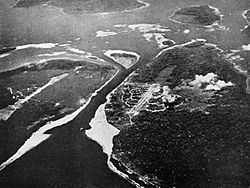Invasion of Buka and Bougainville facts for kids
Quick facts for kids Invasion of Buka and Bougainville |
|||||||
|---|---|---|---|---|---|---|---|
| Part of the Pacific Theater of World War II | |||||||
 View of Buka (right) and Bougainville (left) islands, taken in 1943. The two islands are divided by the Buka Passage. |
|||||||
|
|||||||
| Belligerents | |||||||
| Commanders and leaders | |||||||
| ? | |||||||
| Strength | |||||||
| 24 troops | unknown | ||||||
During World War II, from March 9 to April 5, 1942, the country of Japan took control of the islands of Buka and Bougainville. These islands are located in the South Pacific. At that time, Buka and Bougainville were managed by Australia. A small group of Australian soldiers was on Buka Island when the Japanese arrived. However, they did not fight against the Japanese landing.
Contents
Why Japan Invaded
Japan invaded Buka and Bougainville for important reasons during the war. They wanted to build new military bases there. These bases would help protect their main base at Rabaul, which was on another island called New Britain.
After taking control, the Japanese quickly started building airfields. Airfields are places where airplanes can take off and land. They built major airfields on Buka Island and near Bonis Peninsula. Other airfields were built at Kahili and Kieta.
They also built naval bases. Naval bases are places where navy ships can dock and get supplies. These were built at Buin and on the nearby Shortland Islands.
Protecting Supply Routes
These new bases were very important for Japan. They allowed Japanese forces to operate in the southern Solomon Islands. They also helped Japan attack the supply routes used by the Allied forces. These routes were like highways on the ocean, used to move soldiers and supplies between the United States and the Southwest Pacific.
Allied Response and Later Battles
Much later in the war, in November 1943, Allied forces arrived on the west coast of Bougainville. This was part of a bigger plan called Operation Cartwheel. The Allies wanted to build their own air bases. These bases would help them cut off and weaken the Japanese base at Rabaul.
US Marines and Army Arrive
First, U.S. Marines landed at a place called Cape Torokina. They set up a secure area, known as a beachhead. Within this area, the Allies eventually built three airfields.
In January 1944, U.S. Army soldiers took over from the Marines. They continued the fight.
Australian Troops Take Over
Later, in October 1944, Australian Militia troops replaced the U.S. Army soldiers. They continued the campaign on the island. The fighting on Bougainville finally ended in August 1945. This was when Japanese forces officially gave up.

